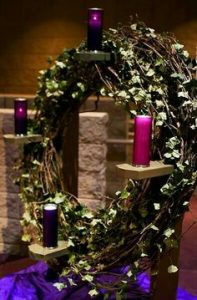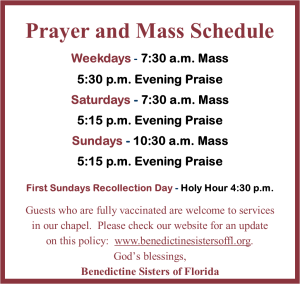 In her book, THE LITURGICAL YEAR, Joan Chittister makes the comment: “Advent, more than any other season of the church year, calls us to live simultaneously in the past, the present, and the future. She elaborates: “We learn in Advent to stay in the present, knowing that only the present well-lived can possibly lead us to the fullness of life. It takes an overview of the three-year cycle of Advent readings to make clear the multiple meanings of Advent. Many of our Advent hymns keep this idea before us when we sing “Mara – natha – two words – The Lord has come … God of, and in, our) past, present and future are all lived together … soul.” (Chittister)
In her book, THE LITURGICAL YEAR, Joan Chittister makes the comment: “Advent, more than any other season of the church year, calls us to live simultaneously in the past, the present, and the future. She elaborates: “We learn in Advent to stay in the present, knowing that only the present well-lived can possibly lead us to the fullness of life. It takes an overview of the three-year cycle of Advent readings to make clear the multiple meanings of Advent. Many of our Advent hymns keep this idea before us when we sing “Mara – natha – two words – The Lord has come … God of, and in, our) past, present and future are all lived together … soul.” (Chittister)
We eagerly await the coming of Christ as a baby in Bethlehem (the past), we are invited to welcome him into our hearts now (the present), and we look forward to his future coming as king of glory. For four weeks of Advent we are suspended in kairos — God’s time — when expectations and reality are held in tension with each other. We must hold on to a vision of what challenges the church (that’s all of us) should be dealing with today. Dwelling in the past or wishing for a perfect future can keep us from hearing the will of God in our today. Many recognize in Pope Francis a voice that is, like John the Baptist, crying in the wilderness … urging us forward in the present to mend the past as we confront the ills of today.
This Gospel introduces us to the man: John. The opening lines in Mark’s gospel are “the beginning of the Gospel of Jesus Christ” but the first character he introducers is not Jesus, but John the Baptist, the fiery preacher who came out of the desert where he lived on honey and locusts. And, he is no fashion plate, with his camel’s hair clothes, leather sandals, and leather girdle around his waist — very much like Elijah. His diet was very simple: locusts (grasshoppers) and wild honey. This is important, or it would not be here. It is symbolic. But what does it symbolize? Well, you cannot wear anything more fundamental in the way of clothing, or eat a more basic diet, than John did. In other words, it is representative of his ministry — one of simple beginnings. It is not the end; it is the beginning. The beginning of the gospel of Jesus Christ, the Son of God is all about repentance. This is the place to begin. Even John’s clothing and his diet helped convey that message.
His diet, by the way, was balanced. Food fanatics will quickly recognize that grasshoppers are protein, and honey is carb. John’s diet was in perfect balance, so that he was a healthy man. It was a simple sort of diet, just as his ministry was – nothing elaborate. Furthermore, he’s very honest. He says, “Don’t look to me for answers beyond what I have already told you. Anything beyond that must come from Another, who is coming right after me. He is so much greater than I that I am not even worthy to untie his shoes. Remember, this was his cousin he was talking about! John could bring people to God, but he could not take them beyond that. John began his ministry in the wilderness, the worst possible place. But it worked!
The people of Jerusalem and Judea left their cities, their recreations and pleasures, and trekked through a howling wilderness to listen to a man preach. They probably had to walk twenty or thirty miles to hear John, but did so willingly and in such increasing numbers that Mark records, in only slight exaggeration, that “all the country of Judea, and all the people of Jerusalem” came out to hear him. Something drew these people into the desert to listen to this strange and rugged young preacher proclaim good news. That is all he did! He never told how it worked, or why; he just announced it.
How fitting it is that we have this message of forgiveness and repentance as a prologue to our Penance Service on Tuesday evening. Then, as now, people need to know they can begin again. God offers us, once again, an opportunity to truly repent. We can change our attitude and stop defending ourselves and trying to blame everything on others. There’s a saying: the whole world’s a critic. Tuesday’s reconciliation service gives us a chance to be our own critic and say, “You know what, God? I’ve finally realized it’s not those others, it is just me. This is just the way I am — and I need help.” In the quiet of your own heart, where God alone hears, you can say, “I repent, send me your Spirit.”
But keep in mind what the prophet Isaiah said about John’s message – this business of reconciliation will resemble a great bulldozer, building a highway in the desert. John was God’s bulldozer to build that highway. You know how roads are built – we see the process almost any direction we go on the highway. Isaiah says: “Every mountain shall be brought low, and every valley shall be lifted up; the crooked places shall be made straight and the rough places plain.” And, that is what repentance does. It bulldozes down all the high peaks of pride that we stand on and refuse to admit we’re wrong. It takes the depressed areas of our life, where we beat and torture and punish ourselves, and lifts them up. It takes the crooked places, where we have lied and deceived, and straightens them out. And it makes the rough places plain. Then, there is God! God comes to us so that we can come to God.
Our hope is in the promise of God, and God of the Promise… a promise that was fulfilled in Jesus Christ. It is a hope that will not be disappointed because God may delay, He may tarry but He will not forget His promise. He will not let us down. Praise be God!
~Reflection by Sister Roberta Bailey, OSB, Prioress

